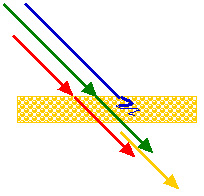|
|

|
|


If we mix red and green pigment in white paint, the red pigment will absorb the green and blue light while the green pigment will absorb the red and blue light. The end result of this will be that no light is reflected at all, as illustrated in Figure 17.24. In actual practice, most pigments will not be totally absorbing for any color so the result will be our usual murky grey or muddy brown instead of actually being black. Pigment reflects what it does not absorb but its active role is absorbing. When paints are mixed together the result is the sum of their absorption characteristics. That is why this is known as color subtraction.



We will also get black, or dark grey or brown, if we mix red (which absorbs green and blue) with blue (which absorbs red and green) or if we mix green (which absorbs red and blue) with blue. These are illustrated in Figure 17.25.




Cyan is light with a wavelength between green and blue or a combination of green and blue light. Cyan pigment will absorb the red and reflect green and blue or cyan colored light. Magenta is a combination of red and blue, without any green. And yellow is seen when red and green light are combined. These colors are illustrated in Figure 17.26.



We have already seen what happens when we mix various combinations of red, green, and blue paint. Now we shall do the same with cyan, yellow, and magenta. Figure 17.27 shows cyan and yellow paint mixed together. The cyan pigment absorbs red while the yellow pigment absorbs blue. Only the green is reflected. It is not uncommon for people to refer to cyan as "blue" so you may already know this in terms of "yellow and blue make green".

Figure 17.28 shows the mixing of cyan paint and magenta paint. Cyan absorbs red while magenta absorbs green. Only the blue remains. Remember, when mixing pigments, it is the colors that are absorbed or taken out or subtracted that compound or accumulate.

Filters placed in front of each other behave in the same way as mixing paint. Pigments in filters selectively absorb different colors and the remaining colors pass through the filters just as the remaining colors are reflected from paint. What happens if a yellow filter and a magenta filter are used together? The yellow pigment in the yellow filter absorbs blue light and allows the red and green light to pass through, making yellow. The magenta pigment in the magenta filter absorbs green and allows red and blue light to pass, making magenta. This is illustrated in Figure 17.29.




We began our discussion of color addition by shining three colored spotlights in an overlapping pattern. Figure 17.30 shows a similar overlapping pattern of colored filters. Overlapping filters of the subtractive primary colors, cyan, yellow, and magenta, allow the additive primary colors, red, green, and blue, to pass through where two of the filters overlap. Where all three filters overlap, no light passes through and the area is black.


A: The cyan filter absorbs red and allows green and blue light to pass on through (cyan is blue-green). The yellow filter absorbs blue. Since the light has only blue and green light in it after passing through the cyan filter, the yellow filter will absorb the blue and let only green light pass through.

|
|